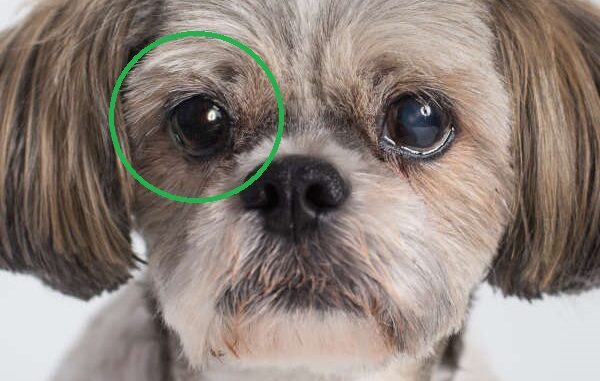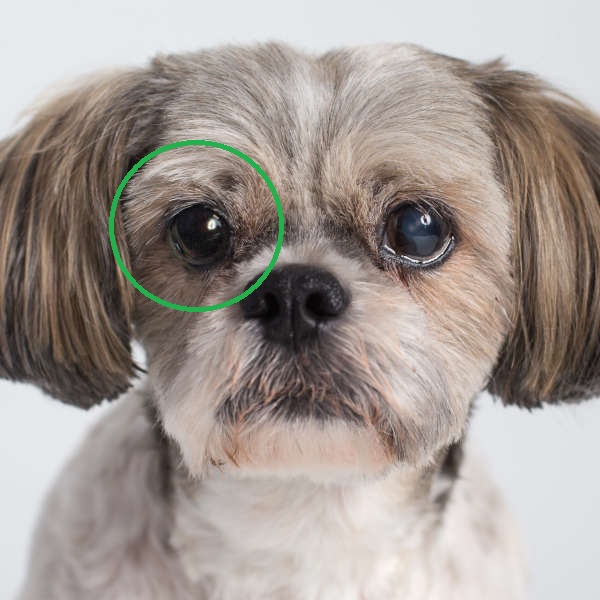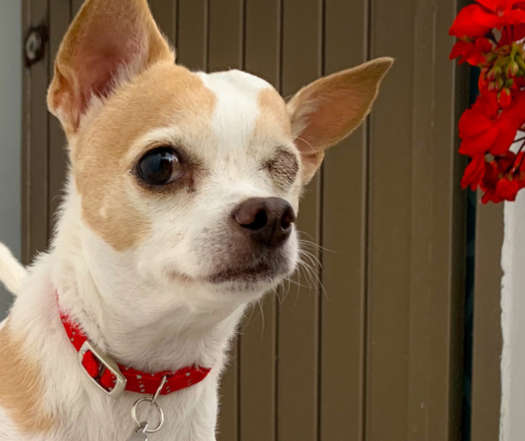
If a dog has an eye removed, a prosthetic eye can be provided as a replacement. This helps avoid the hollow appearance of their socket, and some types even match the original eye in look and style.
Having a prosthetic eye for dogs is just an aesthetic choice; your dog can still lead a perfectly normal life without it. That being said, some pet owners don’t appreciate the idea of having a single-eyed dog with an empty eye socket. Here’s what you need to know before using a prosthetic eye for your pup.
Removal of an eye in a dog:
Enucleation is the medical term for surgically removing a dog’s eye. It’s usually done when your pet is suffering from an acute eye condition and can’t be treated in any other way. When this procedure is performed, the animal loses its sight in the affected eye. A prosthetic eye can make your dog look better after the surgery, however, it cannot help restore the lost eyesight.
Reasons why your dog may require enucleation, include:
- Blind painful eye due to glaucoma or other ocular conditions
- Non-treatable cancer of the eye
- Birth defects of the eye
- Inflammations or infections of the eye that have not responded well to treatment
- Diseases behind or within the eye
3 different types of prosthetic eyes in dogs (Overview)
Dogs have three types of prosthetic eyes to choose from:
1. An orbital prosthesis: an orbital prosthesisis basically a sterile black ball that fits snugly in the eye socket, and the vet sutures the eyelids over it. Unfortunately, your dog will never be able to use the eye again. However, the socket will appear as though the eyelid is simply closed.
2. An intrascleral prosthesis: pet owners also have the option to choose an intrascleral prosthesis to provide a natural-looking appearance. This process involves emptying the animal’s eyeball and putting the prosthesis into its eyelid socket. Because the outer structures of the eye remain, your pet will be able to blink and move his prosthetic eye, so it may appear almost normal. The intrascleral prosthesis is a sterile, grey-colored sphere, unfortunately it will not bring back the vision of your dog’s eye.
3. An extrascleral prosthesis: the extrascleral prosthesis, as commonly used in humans, is a porcelain shell inserted into the conjunctival sac over a disfigure cornea or phthisical globe. (Slatter’s Fundamentals of Veterinary Ophthalmology; David J. Maggs, Paul E. Miller and Ron Ofri; Orbit; page 391)
More information about each type of prosthetic eye option
As we have seen, there are 3 main options. Let’s review them in more details:
1. Intraorbital prosthesis:
Silicone or methyl methacrylate spheres may be used to prevent postoperative depressions of the skin covering the orbit. Insertion of an implant is a safe and inexpensive method of improving postoperative appearance.
An implant should not be placed if the reason for enucleation was neoplasia outside the globe or infection involving the ocular surface, or if the patient has foci of possible hematogenous bacterial infection elsewhere.
Bacterial invasion of the implant can be minimized by prophylactic use of systemic bactericidal antibiotics. The size of the implant is determined by the depth and diameter of the orbit.
The success rate with orbital prostheses in dogs is high (98% to 99%) – (Slatter’s Fundamentals of Veterinary Ophthalmology; David J. Maggs, Paul E. Miller and Ron Ofri; Orbit; page 391)
You can click here to view several pictures of the postoperative appearance of a dog after suture removal. There is an orbital implant under the skin to prevent an indentation
2. Intrascleral prosthesis
Evisceration—removal of the contents of the globe leaving only the corneoscleral shell—is appropriate for insertion of an intrascleral prosthesis in dogs.
The procedure is particularly useful in the treatment of blind glaucomatous eyes, and after severe ocular trauma (in the absence of infection or severe contamination) to prevent phthisis bulbi. The diameter of the implant is equal to the horizontal corneal diameter of the contralateral normal eye plus 1 to 2 mm.
After insertion, the cornea frequently becomes pigmented, usually with an improved cosmetic outcome, but the extent of pigmentation is unpredictable.
The complication rate with this procedure is also low when it is performed in correctly chosen cases.
Complications include corneal mineralization, ulceration, extrusion of the implant, and dry eye. (Slatter’s Fundamentals of Veterinary Ophthalmology; David J. Maggs, Paul E. Miller and Ron Ofri; Orbit; page 390-391)

3. Extrascleral prosthesis:
Typically an eye (i.e., conjunctiva, cornea, and iris) is painted onto the external surface of the shell, although in some animals the dark conformer can be cosmetically acceptable in and of itself. Shell prostheses are used mainly in horses but are available for dogs.
The manufacture and insertion of a shell are time-consuming and expensive, but the shell has gratifying results for clients prepared to bear the cost and time commitment.
Each shell is individually cast to fit the affected eye, fitted over a period of several weeks, and then painted to match the remaining eye. The services of a specially trained oculist are essential. (Slatter’s Fundamentals of Veterinary Ophthalmology; David J. Maggs, Paul E. Miller and Ron Ofri; Orbit; page 390-391).
The glass prosthesis has to be taken out every evening. The prosthesis is placed overnight in a generally available lens cleaner. In the morning, the conjunctival sack is flushed with a generally available eye cleaner, and the prosthesis is placed back into the fornix.
Click here to view pictures of a glass eye for a dog (Hindawi.com case reports of veterinary medicine) and a picture of a Six-and-a-half-month-old Bernese mountain dog with intraocular and extraocular prosthesis two months after surgery on the left eye.
How much do they cost?
The cost of a prosthetic or glass eye for a dog can vary depending on several factors, including the location of the veterinary clinic, the size and breed of the dog, and the complexity of the procedure.
This cost includes the initial consultation with the veterinarian, the cost of the prosthetic eye, the surgery or procedure to implant the prosthetic eye, and any follow-up appointments. The cost may also vary based on whether the prosthetic eye is a custom fit or pre-made, and if there are any additional medical conditions or complications that need to be addressed.
After conducting an examination, your veterinarian will be able to accurately determine the cost of care for your pet, according to their individual medical needs.
Are there precautions to follow when your dog has a new prosthetic eye?
Yes, there are some precautions that you should follow if your dog has a new prosthetic eye. Here are a few things to keep in mind:
Follow Your Veterinarian’s Instructions: Your veterinarian will provide specific instructions on how to care for your dog’s prosthetic eye. It’s important to follow these instructions carefully.
Watch for Signs of Discomfort: Please watch for signs of excessive rubbing, discharge, redness, or swelling around the eye, or other clinical signs. If you have any worries about your pet, do not delay and reach out to a veterinarian for professional guidance.
Monitor Healing: It’s important to monitor the healing process of the surgical site and watch for any changes in the eye socket or surrounding tissue. If you have any worries about your pet, do not delay and reach out to a veterinarian for professional guidance.
Avoid Touching the Eye: It’s important to avoid touching the prosthetic eye or allowing your dog to scratch or rub at it, as this may damage the eye or cause further complications.
Avoid Swimming and Bathing: Until your veterinarian clears your dog for normal activities, it’s important to avoid swimming and bathing to prevent infections or other complications.
Make sure to frequently check your pet’s prosthetic eye for any issues and contact a veterinarian quickly if you observe any abnormalities or if you have any concerns.
What does a dog without a prosthetic eye look like?
Pictured below is a dog without a prosthetic or glass eye (dog’s left eye was surgically removed due to blindness):

In Summary
It’s important to consult with a veterinarian to determine the best course of action for your dog’s specific needs. The decision of which treatment your pet requires will depend on several factors, including the dog’s overall health, the severity of the condition, and the potential risks and benefits of each treatment option.
Disclaimer: This website's content is not a substitute for veterinary care. Always consult with your veterinarian for healthcare decisions. Read More.


Hi my dog needs eye surgery he is a pug and I also want him to have a prostetic eye
Hey Oscar and thanks for your comment. I’m really sorry to hear about your Pug. Sadly, this breed is over-represented when it comes to eye issues and ‘Dry Eye’, ulcers and eye prolapses are all more common due to the position of their eyes in their skull. When an eye is damaged or infected and is beyond healing, removing it is best to prevent infection and ensure it does not cause ongoing pain.
Prosthetic eyes are not commonly used in veterinary, and usually we would suture the skin over where the eye was. Any sort of prosthetic would not be of benefit to the dog, but I appreciate owners may prefer the cosmetic look. Healing time does take longer compared to the more traditional surgery and it is not possible for every eye condition. If you’re strongly considering it, chat to your vet. If they cannot do it for you, they may be able to refer you to an eye specialist.
“The information on this website is not a substitute for in-person veterinary care. Always seek advice from your veterinarian if you have concerns about your pet’s medical condition.”